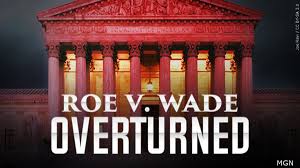Roe Vs. Wade Overturned
September 2, 2022
Roe versus Wade, the case that proved pivotal for women’s’ history and created an enormous division throughout the US, has been overturned. Previous to 1973, abortion was illegal in majority of the US. On June 24, 2022 the ruling of the case, originally decided in 1973 was overturned. This means that states have the right to ban abortion. People across the nation have began taking “sides”: pro-life or pro-choice. People who are against abortion or want abortion to be illegal are pro-life. People who are for abortion and do not want abortion to be illegal are pro-choice.
Roe represents “Jane Roe” and several other women who argued that Texas law violated the fourth and fourteenth amendments. The fourth amendment claims that American citizens have the right to privacy and the fourteenth amendment claims that a state cannot strip its citizens of their rights. Henry Wade was the District Attorney of Dallas County, Texas and it was his job to enforce the illegalization of abortion, so he sued Jane Roe for seeking an abortion. Roe created a document to present to the Supreme Court, but she died before it was read. The document stated her opinion of Texas laws violating her rights, which created the now well known Roe v. Wade case.
On January 22, 1973, the Supreme Court ruled that people have the fundamental right to choose whether or not to have an abortion. In a majority ruling, 7-2, the court found that criminalization of the medical procedure violated the Fourteenth Amendment. The plaintiff “Jane Roe” initiated federal action against the district attorney of Dallas county, Henry Wade. “Roe” aimed to provide people with absolute access to abortion regardless of circumstance. The court, however, focused their energies on balancing the argument, providing the right to bodily autonomy before about the 24th week of the pregnancy.
On June 24, 2022 the Supreme Court eliminated the national constitutional right to abortion in a 5-4 decision regarding the Dobbs v. Jackson case. The case began in 2018 when Mississippi passed a measure titled the “Gestational Age Act” banning abortion after 15 weeks of pregnancy with the only exception being medical emergencies. The Center for Reproductive Rights (CRR) and Jackson Women’s Health Organization, an abortion clinic located in Mississippi, filed the case against Mississippi to challenge and repel the state’s rigorous ban. Mississippi then requested to take the case to the Supreme Court in effort of maintaining the ban. In response, the Supreme Court accepted the state’s request, overturning Roe vs. Wade, reversing all the dissertation’s subsequent precedents and eliminating the federal right to abortion.
Each state now holds jurisdiction for regulation, meaning that specific stipulations do vary from state to state. However, here is a brief overview of our nation as of recently. According to Planned Parenthood, 9 states have completely banned abortion, 35 states have banned abortion after a specified point in pregnancy, 18 states require a waiting period before receiving an abortion and 27 states require some kind of parental involvement in order for a minor to receive an abortion. However, legal disposition and legislation is subject to change and many states are still in the process of determining whether or not to implement bans, restrictions, legislation, protections, etc.
Although there were many cases that challenged the legalization of abortion, in the end the Dobbs v. Jackson Women’s Health Organization case gave states the right to choose the legalization of abortion. The application for this case was instituted during March of 2020, which means that it has taken over 2 years for the decision of Roe v Wade. The vote came out to 5-4 meaning five members of the Supreme Court voted to overturn Roe v Wade. Members Amy Coney Barrett, Samuel A. Alito, Jr., Brett Kavanaugh, Neil M. Gorsuch, and Clarence Thomas voted to overturn the case. Stephen G. Breyer, Sonia Sotomayor, and Elena Kagan voted to uphold it.
The question now is how does this decision change the nation. Some states have already implemented “trigger-bans” which became effective immediately or soon after the Supreme Court’s decision. Other states such as California, Michigan and Vermont will include the reaffirmation of the constitutional right in their midterm election ballots. While on the opposite side of the spectrum, Kentucky will have its citizens vote if the state should not protect the right to an abortion. The world is constantly changing, so it’s important to stay updated on your state’s regulations, as well as your own rights. For more information and resources, go to https://www.aclu.org/issues/reproductive-freedom, https://www.plannedparenthoodaction.org/abortion-access-tool/US, or https://reproductiverights.org/maps/abortion-laws-by-state/.









